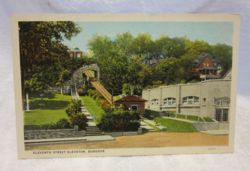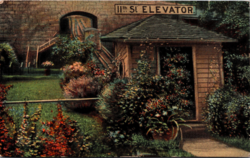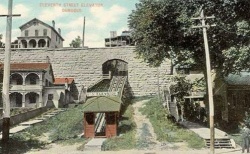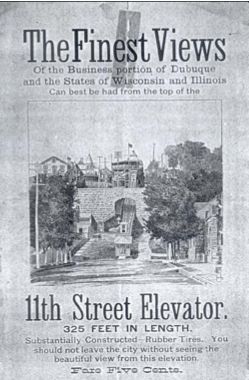Encyclopedia Dubuque
"Encyclopedia Dubuque is the online authority for all things Dubuque, written by the people who know the city best.”
Marshall Cohen—researcher and producer, CNN
Affiliated with the Local History Network of the State Historical Society of Iowa, and the Iowa Museum Association.
ELEVENTH STREET ELEVATOR
ELEVENTH STREET ELEVATOR. The success of the FOURTH STREET ELEVATOR led a group of local citizens including William P. LARGE, George BURDEN, and James Wallis WINNAL on July 1, 1887 to incorporate the Eleventh Street Elevator Company to construct a second elevator at 11th and Bluff to serve residents on the bluff. (1) A partial stairway at the site had proven unpopular due to its steepness. The organization had begun on May 11, 1887 when the investors had met and pledged a stock subscription of $3,100 at $100 per share. (2) James Forrester was the president of the corporation which had twenty-five stockholders with Williard H. TORBERT the secretary-treasurer. (3)
Nearby residents objected to the project, and claims were filed. One resident compared the noise of construction to "a young Niagara." (4) After consideration, the court awarded the neighbors $710, but the board of directors of the corporation chose to move ahead using a wooden rather than steel structure. (5)
The general contractor chosen for the project was F. H. Spaulding of the Shiffer Bridge Company in Pittsburgh. Stone work for the foundations supporting the superstructure was to be done by F. W. Kringle. James Howie, a member of the board of directors, was chosen to build the station houses and platforms. (6)
The total cost was estimated to be between $3,500 and $4,000. (7) The trestle supporting the track was to start at 11th and Bluff and rise to Grove Terrace at an ascent of 43.3 feet in 100ft. The track was designed to rise twenty-five feet over Grove Street allowing vehicles to pass. A "midway" station was to be constructed at the foot of Grove. From Grove to the end at Highland Place the grade would decrease to 27.3 feet in 100 feet to a third station. (8) The track was similar to the one used on Fourth Street. As one car moved up the track another came down.
An injunction against construction was filed on November 10th by George W. Andrew and Charles Thomas HANCOCK who claimed among other things that the passengers would be able to look into the petitioners' windows invading their privacy. (9) This case was dismissed. They attempted a second restraining order in 1889, but the case was eventually dropped. (10)
Placed in operation on May 13, 1888, the elevator cost three cents to climb the hill and two cents to return. (11) Selling points for the elevator included claims that it provided wonderful views of the city and would encourage the construction of homes on vacant lots. (12) Electricity had been added to the operation in 1890 to replace the steam power. (13) This was the result of efforts of Allen & Swiney to encourage the use of electric power. (14)
The elevator was rebuilt in 1896 using one continuous grade. (15) Space for the track was cut through the stone retaining wall parallel to Bluff Street. Isaac Proctor was hired to construct a wall "on the east side of DeSoto Terrace" after the property at 1090 Grove Terrace was filled. In 1898 the city determined that the wall had not been built to municipal specifications and refused to accept it. In mid-1898 the elevator company explained that its operating loss that year was caused by the costs of constructing the wall and gave it to Proctor. By 1899 the structure was known as "Moro's Wall." (16)
On January 31, 1910 two armed hold-up men entered the elevator house and took all the money--$24.05. C. W. Daniels, the manager, believed the two were around the age of nineteen and both covered their faces with white handkerchiefs. Once the robbers fled, the manager located his own pistol and fired twice in the air to alert neighbors. Believing they were being fired upon, the robbers turned and fired at the elevator house. Daniels returned fire once. (17)
The increased use of automobiles led to a decline in the number of elevator passengers. In 1927 the elevator was abandoned. (18) The elevator was demolished in 1929. (19) Concrete steps pass through the remaining arch.
Andrew Brachman chose the renovation of the landing area as his Eagle Scout project. Brachman installed the landscaping, fencing, brick pavers, a bench, and a plaque on the West Eleventh Street Elevator landing. (20)
---
Source:
1. "Notice of Formation of Eleventh Street Elevator Company," Dubuque Daily Herald, July 14, 1887, p. 4. Online: http://news.google.com/newspapers?id=YXhFAAAAIBAJ&sjid=v7wMAAAAIBAJ&pg=6847,255088&dq=eleventh+street+elevator+dubuque&hl=en
2. Friedman, Larry and John P. KLAUER. "The Rise and Fall of the Eleventh Street Elevator," Julien's Journal, March 2013, p. 52
3. Kruse, Len. My Old Dubuque, Dubuque, Iowa: Center for Dubuque History, Loras College, 2000, p. 62
4. "Local News in Brief," Dubuque Daily Herald, May 18, 1888, p. 4. Online: http://news.google.com/newspapers?id=YXlFAAAAIBAJ&sjid=xrwMAAAAIBAJ&pg=1719,6369397&dq=eleventh+street+elevator+dubuque&hl=en
5. Kruse, p. 63
6. Friedman, p. 52
7. Ibid.
8. "Eleventh Street Elevator," The Herald, July 3, 1887, p. 5
9. "Eleventh Street Elevator," The Herald, November 11, 1887, p. 4
10. Friedman, p. 52
11. Ibid. p. 53
12. Ibid.
13. "Eleventh Street Elevator," Preservation Iowa. Online: http://www.preservationiowa.org/programs/awardsItem.php?id=112&year=2007
14. "Local News in Brief," Dubuque Daily Herald, April 29, 1890, p. 4
15. "Architectural Walking Tour of the Jackson Park and West 11th Historic Districts," Online: http://mandolininn.com/blog-post-1/
16. National Register of Historic Places. Online: http://www.cityofdubuque.org/DocumentCenter/Home/View/2928
17. "Hold-Up Men Rob 11th St. Elevator," Telegraph Herald, February 1, 1910, p. 8
18. Ibid.
19. Friedman, p. 53
20. "Eleventh Street Elevator," Preservation Iowa. Online: http://www.preservationiowa.org/programs/awardsItem.php?id=112&year=2007







